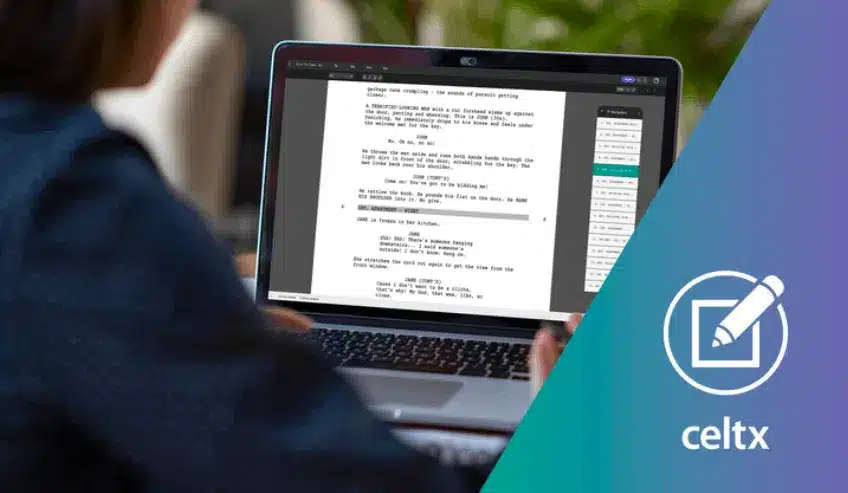
Crafting a screenplay is like building and then tinkering with a well-oiled machine. We have all of our components (characters, action, dialogue, structure) which we then combine to create the moving parts (scenes) that create a cohesive and compelling narrative (the machine).
But what about what goes in between those parts that ensures the machine operates well. Yes, today we’re talking all about scene transitions and how they connect scenes to one another in a screenplay.
In today’s blog, we’ll be defining the scene transition, understanding what that means from a visual perspective in film and also how we can effectively use transitions in our screenplays.
So, let’s allow our imaginations to run wild as we dive into the world of scene transitions!
Table of Contents:
- What is a Scene Transition?
- Types of Scene Transitions in Film & Screenplays
- The Do’s & Don’ts of Scene Transitions
- How to Use Scene Transitions to Enhance Pacing & Storytelling
- Conclusion
What is a Scene Transition?
Scene transitions, also known as ‘cuts’ are one of the core elements of a screenplay. They are situated on the right-hand side of the page, to show how the film should move from one scene to the next.

Scene transitions also indicate pacing and the emotional impact of the script, allowing us as screenwriters to convey everything from a passing of time, character movement and pauses as well as the tension and momentum of the story.
We convey these key story elements not just to the audience, but to core members of the production team, including the director and cinematographer.
Screenwriters will usually only focus on visual scene transitions, however movement between scenes can also come through music and sound effects.
Focus on storytelling, not formatting. Use Celtx to streamline your scene transitions and keep your screenplay organized.
Start your free trial today!
Types of Scene Transitions in Film & Screenplays
You will have already had a sneak peek of one of the transitions in the previous image, but let’s take a closer look at some types of transitions in film, and most importantly, the screenplay.
We’ll start with the most common before moving onto the less known.
1. CUT TO
The most basic of the transitions which cuts straight to a new scene. No passage of time is implied here, a mere emphasis on the cut between two scenes.
You’ll find CUT TO is mostly used to highlight a contrast.
Here, in the script for Harry Potter and the Chamber of Secrets, screenwriter Steve Kloves, uses CUT TO to move from Harry, Ron and Hermione preparing to drink the Polyjuice Potion, to them actually going ahead.
Time has moved forward quickly to keep the audience engaged at this highly tense moment in the story:
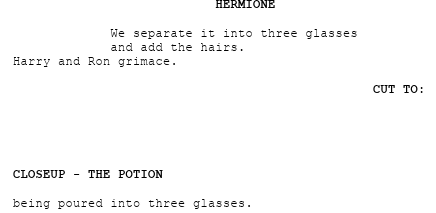
2. DISSOLVE TO
Similar to CUT TO, this is a smoother transition between two scenes which indicates a shift in mood or a passing of time.
Earlier in Harry Potter and the Chamber of Secrets, Kloves uses DISSOLVE TO after Fred, George, Ron saves Harry from his bedroom. This shows a longer passage of time to them leaving Harry’s house and arriving at The Burrow.
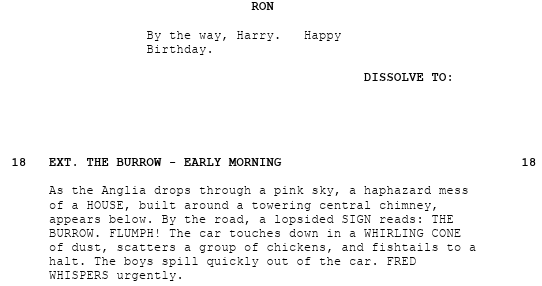
3. FLASH CUT TO
One of the most abrupt scene transitions, this is often used to show flashbacks or create a bamboozling effect. As the name suggests, it can be a flash of an image on screen.
4. MATCH CUT TO
One of my favorites, MATCH CUT TO connects two scenes with similar visuals, such as the same shapes, colors or imagery.
5. SMASH CUT TO
Similar to the FLASH CUT but multiplied by ten. This should be used even more sparingly to show a severe contrast between two scenes.
6. FADE IN | FADE OUT | FADE TO
A three-in-one, the fade transitions are used at key points in the script.
- FADE IN at the start
- FADE TO a dream sequence or flashback
- FADE OUT at the end (you could also use FADE TO BLACK here)
7. IRIS IN | IRIS OUT
This transition emphasizes a specific element within a scene, drawing an audience’s eye. It also indicates to the director and cinematographer what they should focus on during shooting.
8. WIPE TO
Here, the new scene is pushed over the previous one. This one is not so common anymore but can be effective if you’re looking to show something specific or emanate a particular style.
9. INTERCUTS
This isn’t a specific cut you’ll find in the scene transition section of a script, but it’s a common technique used by screenwriters and filmmakers to cross back and forth between two shots happening at the same time.
For example, if two characters are having a phone conversation and you want to show each character talking in their separate location, you can indicate this in the script.
A great example of an intercut scene is this one from prolific screenwriter, John August:
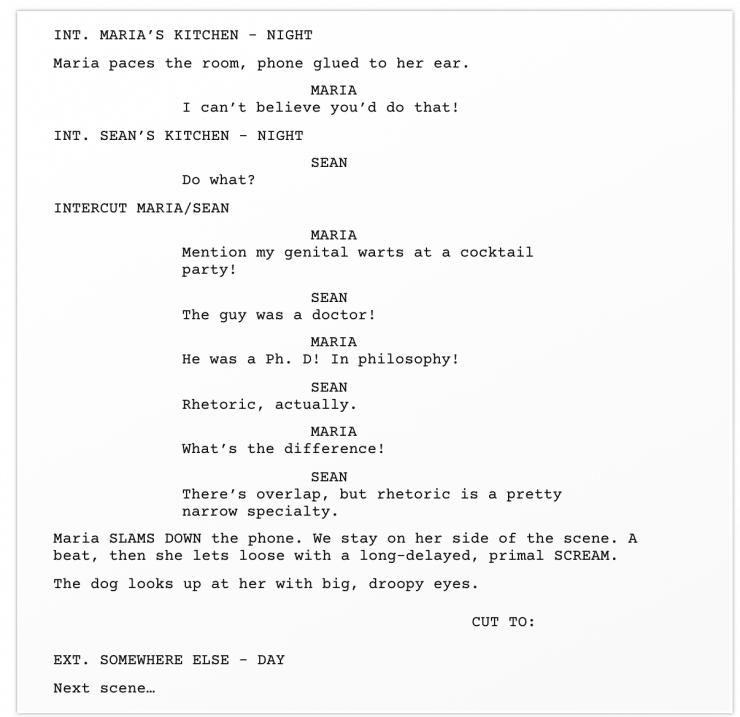
You’ll see that this transition works a little differently, as August establishes the two scenes separately first with their own scene headings. After that he indicates the intercut with a separate scene heading:
INTERCUT MARIA/SEAN
When it comes to shooting the scene, the director and cinematographer will now know that they’ll need to cut between Maria and Sean as they speak in turn.
Scene transitions made easy with Celtx!
Write, format, and perfect your screenplay all in one place.
Try it today!
10. BACK TO
Sometimes, you may want to insert a short clip or moment relevant to but separate from the main action. This would be a short CUTAWAY.
This is perfect if you want to insert a quick flashback as a character remembers something crucial that’s related to what’s happening in the scene.
Let’s take a look at another prime example from John August:
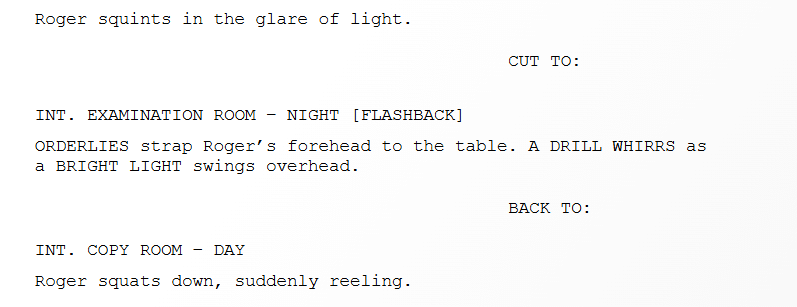
So, how do these transitions translate into the visual product? Check out this wonderful video from Full Time Filmmaker who explores this in depth.
The Do’s & Don’ts of Scene Transitions
Using transitions effectively can enhance our script’s pacing, maintain audience engagement and reinforce the emotional beats of our story.
However, if poorly executed, transitions can cause confusion and interrupt the flow of the narrative.
Let’s explore some of the dos and don’ts of scene transitions.
Do:
1. DO Use Transitions to Maintain Momentum
Film transitions should drive the story forward without jarring the audience. Even if this is moving to a new location, changing time periods, or shifting focus to another character, seamless transitions keep the pacing natural.
In the early pages of The Social Network (2010), screenwriter Aaron Sorkin uses CUT TO after Erica dumps Mark and he leaves the bar. CUT TO is used in quick succession here to show Mark’s determination in these moments and how his action speeds up the pace of the story.
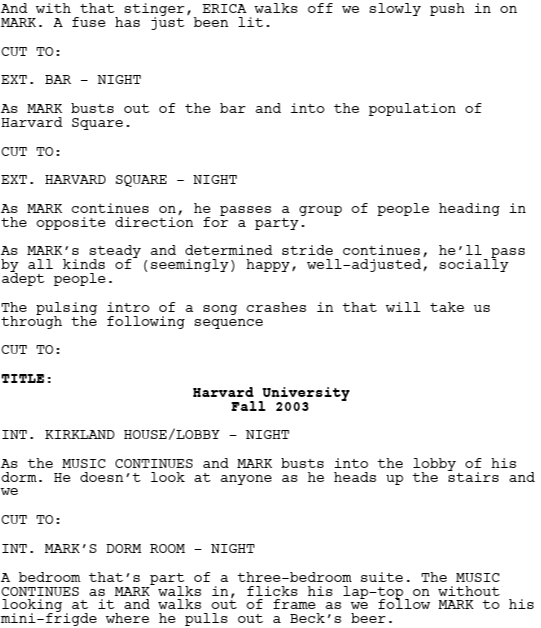
2. DO Use Transitions to Build Suspense or Surprise
By using transitions to evoke suspense in an audience, they’re eager to know what’s going to happen next.
Transitions in this regard can help us to hint at danger, tease future events, or even completely surprise.
Peter Brenchley and Carl Gottlieb’s script for Jaws (1975) cleverly uses DISSOLVE TO in order to show passages of time and build suspense as Hooper, Quint and Brody try to capture the shark.
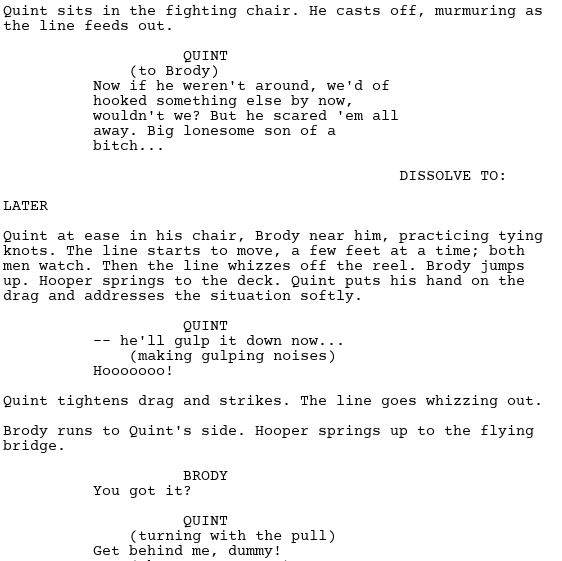
3. DO Vary Transitions
Be aware of the different transitions and their specific purposes. For example:
CUT TO: a standard transition for moving between scenes quickly.
FADE IN / FADE OUT: used at the start and end of the story.
MATCH CUT: visually or thematically links scenes.
DISSOLVE TO: gradual transition used for flashbacks, to show a passage of time, or even dream sequences.
You should be able to explain exactly why you’ve used each transition and the intended effect it has on the two scenes it links.

Dont’s
1. DON’T Overuse Transitions
It’s very tempting to use transitions all the way through your script, but it’s one of the biggest mistakes you can make. If transitions appear too often, you’re in danger of diluting their impact on the audience.
For example, if you constantly use DISSOLVE TO between your scenes, you could disorientate or even bore the viewer. Take care in crafting each transition into the scenes that need them.
If a transition won’t help drive the story forward, then don’t use it!
2. DON’T Rely on Transitions to Fill in Gaps
If you have a plot hole or weak point in your script, go back and fix it. While transitions can be used to show a passage of time, they won’t solve problems for you.
The audience needs to follow your story and have all the information they need, which a transition can’t provide.
3. DON’T Overcomplicate Things
While you shouldn’t overuse transitions, don’t overcomplicate it either. You don’t need transitions in your screenplay if you don’t feel they’re necessary and find yourself in a tangled mess.
Sometimes you may want to add in a CUT TO transition to show a new scene beginning in quick succession to the last, but it’s not compulsory.
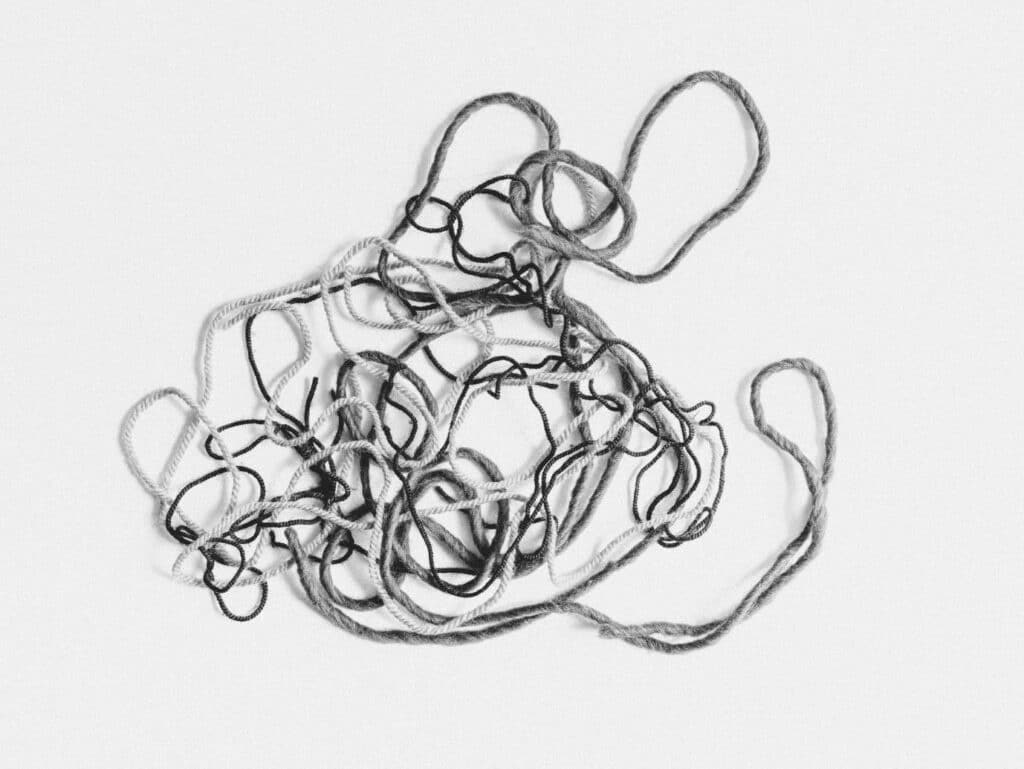
Remember, a screenplay is the blueprint for the movie, so you’ll want the director and cinematographer to make interpretations and put forward their own ideas too!
The truth is that scene transitions are a hugely debated topic in the screenwriting world. Some will say that you shouldn’t use them at all, and they’re in the same realm as camera directions – off limits to screenwriters!
Others are of the opinion that we should use them however we like. In fact, the middle ground is where we should be. Using transitions only when absolutely necessary is probably the best way to go, especially if you’re early on in your career.
How to Use Scene Transitions to Enhance Pacing & Storytelling
As we’ve seen, transitions are partly there to control the pacing and tone of a script. We can speed things up during moments of action, or slow things down when we want more emotional depth in a scene.
Not only do transitions define a pace, but they also allow us to build a thematic connection between scenes which contributes to the overall narrative.
Let’s dive a little deeper into this and focus on how transitions can both speed up and slow down screenplay pacing.
Fast Transitions
Quick cuts such as CUT TO, MATCH CUT TO, SMASH CUT TO, and INTERCUT deliver quick-fire information which can both heighten tension and convey a state or urgency.
Think a car chase in your favorite action movie! The quick cuts between the pursuer and the pursued increase the energy and excitement of the scenes and once matched with high-octane music and heart-pumping sound effects, you can evoke an amazing response from an audience.
While the quick cuts make us really pay attention, they also create a sense of flow and continuity, like we’re with both characters at the same time, truly invested in their journeys.

Slow Transitions
Now, when we look at DISSOLVE TO and FADE IN, FADE OUT, and FADE TO, these work in the opposite way to the fast transitions. In contrast, slow transitions deliver information gradually, creating a sense of calm and consideration.
Think of a highly emotional scene in your favorite drama series. In these moments, we linger in the scene, zeroing in on what the characters are saying and doing.
In an ideal world, you want to employ a mixture of slow and fast transitions within your script to keep your audience on their toes. Too slow, and they could become bored. Too fast and they could easily become confused.For more video transition ideas, take a look at the video below from Studio Binder:
Conclusion
Mastering scene transitions is an essential skill for any screenwriter, as they shape the pacing, mood, and flow of a screenplay.
Whether you’re using quick cuts to build tension or slow fades to create emotional depth, the right transition can enhance storytelling and engage your audience.
The key is to use transitions with intention and to avoid overuse while ensuring each one serves a clear narrative purpose.
By understanding the impact of different transitions and applying them effectively, you can craft a screenplay that feels seamless, dynamic, and visually compelling. Now, go experiment and make your scenes flow effortlessly!
Try Celtx Today – Script writing software for storytellers
Tell your story with Celtx’s multi-format script editors and easy-to-use script writing tools.
Ready to keep learning? Try these articles next:
- How to Write a Logline [Video and Examples Included]
- Hook, Hold, and Deliver: The Screenwriter’s Guide to Pacing
- What is a Slugline? Definition, Examples, and Tips
